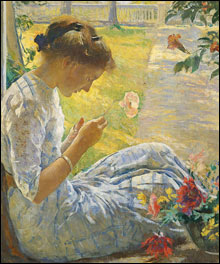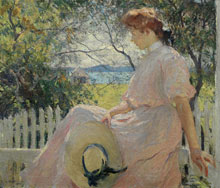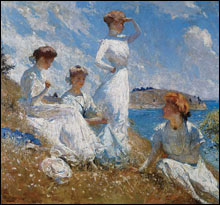The girls of summerFrank Benson and Edmund Tarbell at the MFA and the Peabody Essex
August 10,
2006 9:33:50 AM

Mercie Tarbell cuts flowers
|
Americans, Henry James wrote in 1867, “can pick and choose and assimilate and in short (æsthetically, etc.) claim our property wherever we find it.” In 1867 Frank Weston Benson and Edmund Charles Tarbell hadn’t yet found French Impressionism — both were just five years old — but when they did as student artists in Paris in the 1880s, they followed James’s prescription. Both are represented in the Museum of Fine Arts’ “Americans in Paris 1860–1900” and the Peabody Essex Museum’s “Painting Summer in New England,” and together they tell a story of American — more specifically Boston — Impressionism, one that doesn’t necessarily end the way James would have written it.
They were born just a month apart, Benson in Salem, Tarbell in West Groton. Both studied at the School of the Museum of Fine Arts in Boston and the Académie Julian in Paris; both were married in 1888, Benson to Ellen Peirson, Tarbell to Emeline Souther; both joined the faculty of the MFA School the following year. In the 1890s they shared a studio on St. Botolph Street in Boston, taught classes in New Castle, on Great Island, opposite Portsmouth, and painted together in the shadow of Mount Monadnock. In 1897 they broke away from the Society of American Artists and became founding members of Ten American Painters; in that same year the New York writer Sadakichi Hartmann coined the word “Tarbellites” to describe the Boston School, a conceit that can hardly have flattered Benson. They remained lifelong friends (Tarbell died in 1938, Benson in 1951); in 1900, however, Benson and his family began to summer in Maine, eventually settling on North Haven in Penobscot Bay.

Eleanor Benson seems to be waiting for them
|
Hartmann could as easily have called the Boston School the “Bensonites,” but that aside, they were hardly the same artist. At the MFA, Benson’s Eleanor (1907) and Tarbell’s Three Sisters — A Study in June Sunlight (1890) hang next to each other. Tarbell painted Emeline seated between her two sisters in the garden of the Tarbells’ Dorchester house and holding their new baby, Josephine. He’s flattened the picture plane and streaked the abundant foliage and the ladies’ summer dresses with light, and Emeline’s poufy red hat is the painting’s focal point (with an echo in the red rose that Josephine holds), but the faces and bodies resist the vibration of their surroundings, and Emeline’s pursed, almost pinched lips — her usual look in her husband’s work — suggest that motherhood is no garden party.
Benson’s portrait of his eldest daughter is a little tighter in its landscape, a little freer in its face and figure. Seated on the porch of the family’s North Haven home, picture hat in hand, ocean in the distance, 17-year-old Eleanor evokes Newport in the way that James writes about on the opening page of “Daisy Miller”: “There is a flitting hither and thither of ‘stylish’ young girls, a rustling of muslin flounces, a rattle of dance-music in the morning hours, a sound of high-pitched voices at all times.” Eleanor seems perched on the railing, waiting, as if a young gentleman were about to enter along the white picket fence and whisk her off. Remote North Haven was not Newport; one wonders what kind of social life she had.
Benson’s contribution to “Painting Summer in New England,” Summer (1909), is even more iconic and romantic: its four young ladies — Elizabeth Benson, Anna Hathaway, Eleanor Benson, and Margaret Strong — atop a coastal hillock could be goddesses on a Greek isle. Eleanor stands, looking out to sea, right hand on waist, left shading her eyes, as if sighting one of James’s titled Europeans about to drop anchor and bespeak her millions; the other three sit and converse. Benson has painted Eleanor’s dress, all white light and azure shadows, as if she were just one more cloud slipping across the sky, Daughter Nature. It’s sobering to look at the photograph of her in the same pose that’s in the Peabody Essex’s collection: she’s less fresh-faced, less wasp-waisted, less fragile and delicate. Eleanor herself had no illusions; “He always made us more beautiful than we were,” she said.

Benson’s Summer girls fantasize about husbands
|
Backing Summer on a freestanding wall is Tarbell’s Mercie Cutting Flowers (1912), the (conscious?) obverse of Eleanor. His daughter, also 17, sits on the edge of the family’s front porch, intent on her work of cutting and arranging for the bowl alongside. Her muslin frock is simpler than Eleanor’s; her shorter hair is less artistically arranged. Beyond her an ample walkway and lawn lead to the front gate, but Tarbell has tipped it up (or perhaps he’s looking down), so that Mercie seems to be sinking to the bottom of the picture, whereas Eleanor seems to be rising out of hers. Eleanor might be posing for Charles Dana Gibson; Mercie looks more like a Norman Rockwell.
Tarbell’s other contribution to “Americans in Paris,” Across the Room (circa 1899) hangs alongside John White Alexander’s Repose (1895). Both depict women lounging on sofas, but whereas Alexander’s lady, all elongated sinuous curves, is an Art Nouveau poster girl, Tarbell’s, dwarfed by the tipped-up polished floor, is a Henry James American on the Continent, young, beautiful, and as lost in the huge room as she is in the world of European manners. She could be a cover portrait of Daisy Miller, or Maggie Verver, or Milly Theale.
|
 |
Vote now in over 100 categories including the best local restaurants, comedian, filmmaker, performance artist, and yoga studio
Vote now in over 100 categories including the best local jukebox, bartender, dance club, and tattoo shop
Vote now in over 100 categories including best beer selection, bike route, gallery, and movie house

|
- Fans are paying the price for the Sox success: inside the Fenway fiasco
- The soap-operatic significance of the Bay Guardian–Village Voice Media battle
- Some Things at Trinity
- Never mind its tough-girl alt-porn feminism: SuicideGirls has already moved on to a new generation
- The Big Hurt: Trent Reznor pushes the premium fabric-bound envelope
- The first political leader of my generation acts nothing like the rest of us — which might be how he’s gotten where he is
- Fans are paying the price for the Sox success: inside the Fenway fiasco
- Meet Adam Gaffin, Boston’s reigning Web czar
- The Clean House at New Rep; Gary at Boston Playwrights’ Theatre
- The soap-operatic significance of the Bay Guardian–Village Voice Media battle
- Teatro Lirico I at the Majestic Theatre, March 2, 2008
- The first political leader of my generation acts nothing like the rest of us — which might be how he’s gotten where he is
|
-
Boston Ballet’s ‘Next Generation’
-
Teatro Lirico II at Cutler Majestic Theatre, March 1, 2008
-
Words of Love | LML Music
-
Benjamin Zander and the Boston Philharmonic Orchestra at Sanders Theatre, February 24, 2008
-
Boston Ballet hitches up with John Cranko’s Romeo & Juliet
-
‘Masters of Motion’ in Providence
-
My Fair Lady at the Opera House
-
Mariss Jansons and the Royal Concertgebouw at Symphony Hall, February 1, 2008
-
Samuel Bak’s ‘Remembering Angels’
-
Handel and Haydn's 'Fireworks' at Symphony Hall, January 25, 2008
|

- John Whalley's "Mementos" at Greenhut Galleries
- Taking stock of the war in Iraq
- Monumental Prints and Small Ponds at the Davis Museum, ‘Art and Math’ at Axiom, Glass Sea Creatures at Harvard, and New Rationalists at Proof
- A look at the newly re-opened Bowdoin College Museum of Art
- Global warming inspires eco art at Montserrat and the BCA
- Three approaches to photography at Whitney Art Works
- ‘War Stories’ and Maori tattoos, plus the SMFA’s ‘Traveling Scholars’
- Jared Radding at the new Franklin Street Art Space
- Moyra Davey at the Fogg, ‘Two or Three Things I Know about Her’ at the Carpenter Center, and Arno Rafael Minkkinen at BU
- Commemorating the Katahdin Lake purchase
|
|